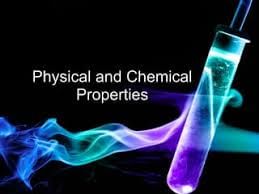Class 7 Exam > Class 7 Notes > Year 7 Chemistry (Cambridge) > Physical and chemical properties
Physical and chemical properties | Year 7 Chemistry (Cambridge) - Class 7 PDF Download
Introduction
- Properties of substances can be categorized into physical and chemical properties.
- Understanding these properties helps us describe and predict how substances behave.

Physical Properties
- Luster: Describes whether an object appears shiny or dull.
- Example: Gold has a shiny luster.
- Hardness: Measures the ability of a substance to resist being scratched.
- Example: Diamond is the hardest natural substance.
- Ductility: Ability of a substance to be drawn into wires.
- Example: Copper is highly ductile.
- Malleability: Ability of a substance to be hammered or rolled into thin sheets.
- Example: Aluminum foil is malleable.
- Conductivity: Ability of a substance to conduct heat or electricity.
- Example: Copper is a good conductor of electricity.
- Density: Mass of a substance per unit volume.
- Example: Lead is dense because it is heavy for its size.
- Solubility: Ability of a substance to dissolve in a solvent.
- Example: Salt dissolves easily in water.
- Melting Point: Temperature at which a substance changes from solid to liquid.
- Example: Ice melts at 0°C.
- Boiling Point: Temperature at which a substance changes from liquid to gas.
- Example: Water boils at 100°C.
Question for Physical and chemical propertiesTry yourself: Which physical property describes the ability of a substance to resist being scratched?View Solution
Chemical Properties
- Flammability: Ability of a substance to ignite and burn.
- Example: Paper is flammable.
- Radioactivity: Ability of a substance to emit radiation.
- Example: Uranium is radioactive.
- Oxidizing Ability: Ability of a substance to promote combustion.
- Example: Hydrogen peroxide is an oxidizer.
- Corrosiveness: Ability of a substance to deteriorate or destroy other materials.
- Example: Acid can corrode metal.
- Toxicity: Ability of a substance to harm living organisms.
- Example: Mercury is toxic to humans.
- Explosiveness: Ability of a substance to explode under certain conditions.
- Example: TNT is explosive.
- pH Level: Measure of acidity or basicity of a substance.
- Example: Lemon juice is acidic, while soap is basic.
Conclusion
- Understanding physical and chemical properties helps scientists predict how substances will interact and behave in different situations.
- These properties are essential for various fields such as chemistry, materials science, and environmental science.
The document Physical and chemical properties | Year 7 Chemistry (Cambridge) - Class 7 is a part of the Class 7 Course Year 7 Chemistry (Cambridge).
All you need of Class 7 at this link: Class 7
|
7 videos|15 docs|8 tests
|
FAQs on Physical and chemical properties - Year 7 Chemistry (Cambridge) - Class 7
| 1. What are physical properties? |  |
Ans. Physical properties are characteristics of a substance that can be observed or measured without changing the substance's composition. Examples include color, density, melting point, and boiling point.
| 2. What are chemical properties? |  |
Ans. Chemical properties describe how a substance interacts with other substances to form new substances. These properties can only be observed when the substance undergoes a chemical reaction. Examples include flammability, reactivity, and toxicity.
| 3. How do physical and chemical properties differ? |  |
Ans. Physical properties can be observed or measured without changing the substance's composition, while chemical properties describe how a substance interacts with other substances to form new substances. Physical properties are intrinsic to the substance, while chemical properties involve a substance's ability to undergo a chemical change.
| 4. Can physical properties be used to identify substances? |  |
Ans. Yes, physical properties can be used to help identify substances. By comparing the physical properties of an unknown substance to known substances, scientists can determine the identity of the unknown substance. However, physical properties alone may not always be sufficient for identification.
| 5. How are physical and chemical properties important in everyday life? |  |
Ans. Understanding physical and chemical properties is essential in various fields such as chemistry, materials science, and medicine. These properties help scientists predict how substances will behave under different conditions, leading to the development of new materials, medicines, and technologies.
Related Searches
















